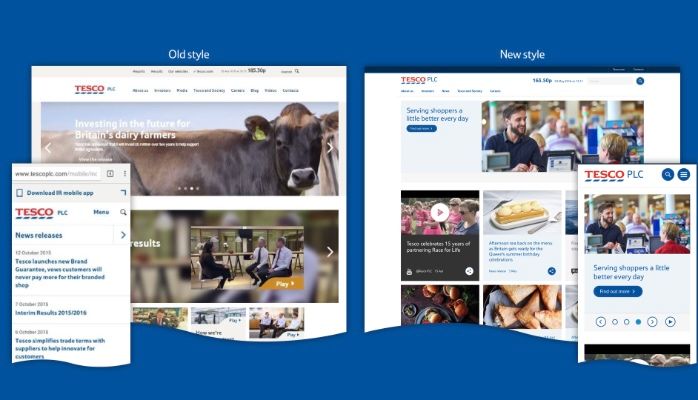Making Tesco’s websites more helpful by design
 Before and after
Before and after
Customers using Tesco online probably aren’t aware that our digital estate includes over 100 different websites and dozens of apps. But they do notice when something blocks them from getting what they need. They’ve been telling us they often find it difficult to move between different Tesco sites, and struggle with having to do things differently on each different platform.
So we’re changing. Last week the Tesco PLC website got a new look. This is just the first of many of our sites and apps changing in line with a new Tesco style: we call it Tesco’s Digital Design Language.
The Digital Design Language is a toolkit to help Tesco teams create websites and apps in a way that ensures they’re recognisably ‘Tesco’ and designed to be helpful for customers. How? We’re doing this by creating a set of commonly used elements (like forms and buttons) along with some basic rules for colour, fonts and layouts that help teams to build quickly and consistently.
Everything we design is guided by how we can serve shoppers better; such as making sure that the ‘Menu’ option is always in the same place so it’s easy to navigate around our sites. And every element is tested with customers so we make sure we’re implementing the easiest, most user-friendly elements. We’ve defined colour and sizing rules to make clear the difference between words that are there to help people navigate (such as ‘Next’) and words that are part of the content of the page. On their own these are little things, but when they add up they will make a big difference to our customers just by making their online experience smoother.
As you can see in the PLC site, the new style is much simpler, and less-cluttered. This means the stuff that’s most important to our customers, our products and content, is easy to find.
This is just the first of many improvements and marks an important stage in Tesco’s digital maturity. In the past we’ve worked hard to create many different ways to meet our customers’ needs wherever and whenever they arise, and it’s now time for us to start joining those various pieces together into a simple, more consistent, more joined up experience for customers. Watch this space.
Design systems design language